
2022
-
2023 Theatrical Season Report
Annual Analysis of Employment, Earnings, Membership and Finance
Russell Lehrer, Researcher

3
Is theatre in crisis? Is our industry in recovery? Over the last several months, I’ve heard these
questions asked over and over again. Both reveal the anxiety that many in our industry are
feeling at the end of the second full season to take place since the COVID-19 pandemic
shutdown. And as long as we continue to measure time by our distance from shutdown and
reopening, both questions will remain relevant.
Some sectors of our industry have returned more quickly and more robustly than others. But
for those stage managers and actors who haven’t yet returned to their pre-pandemic level of
employment, seeing others’ success may be cold comfort. And that goes double for those who
had not yet reached the level of employment they hoped for prior to the shutdown. Employers
who are laying o sta and tightening budgets are unlikely to feel relieved seeing their
colleagues at other theaters operating in full force.
But as you’ll read in the pages to come, by many of our benchmarks, the union’s numbers are
approaching – or in some cases, exceeding – some of our best seasons on record. It’s my hope
that this report will calm some of our worries, even if it doesn’t quite answer all of our questions.
We can feel encouraged by the positive trajectory this report describes, but let’s not celebrate
quite yet. ere is still work to be done to shape our industry into one that provides opportunity
to all its workers for a sustainable, middle-class life. But if there’s one message the labor
movement has for us and the world, it’s that together we can make that happen.
In solidarity,
Al Vincent, Jr.
FROM THE EXECUTIVE DIRECTOR

4
Coming out of an industry-wide shutdown, many of us – myself included – still view the
world through that lens. After years of consistently disappointing news, it can be jarring to
see evidence of a return to normalcy. And it is right and necessary to compare our individual
experiences to those of the union membership as a whole and the industry overall.
is report tells your stories. Every data point in this report is connected to an individual
member like you – the auditions or interviews you attended, the salary you were able to
negotiate and the work you performed backstage and on stage, as well as the contract terms only
achievable through your combined strength.
is report is a collective view of those individual experiences, one which shows remarkable
resilience. By every metric discussed here, the 2022–23 season was the healthiest for our
membership since the shutdown. Refreshingly, in many instances they approached or even
exceeded the pre-shutdown records for the union. But in areas where recovery lags, members
continue to struggle, and Equity continues to ght for your employment opportunities and
earnings.
Russell Lehrer
INTRODUCTION
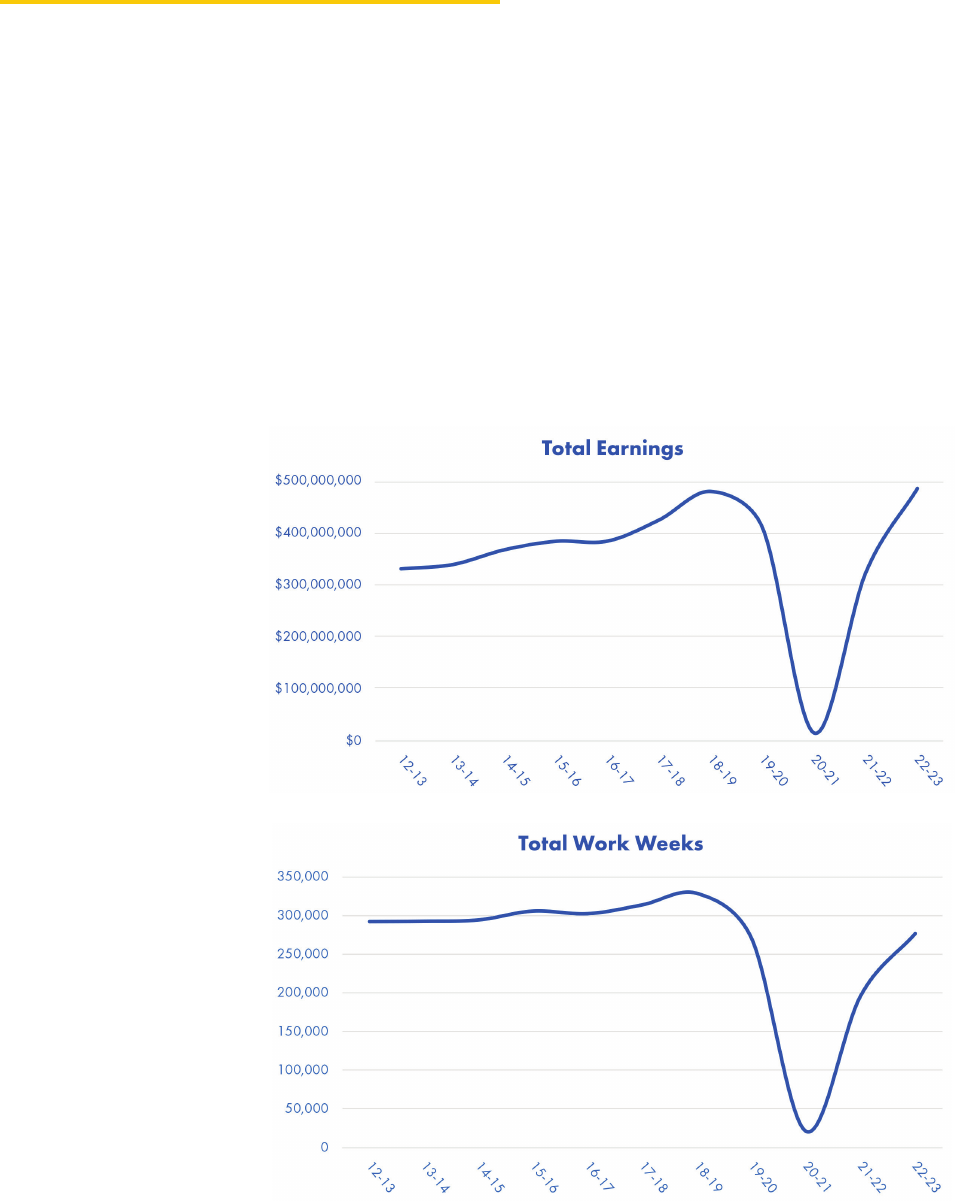
5
e theatrical season, as referenced throughout this report, runs from June to May of every year.
In the 2022–2023 season members generated 276,757 work weeks, earning $474,919,343 across
all our contracts. So, how does this season compare to the previous 10 seasons, and to what
degree has the industry recovered from the 2020 shutdown?
e last full season before the COVID-19 industry shutdown – the 2018–2019 season – saw
historic highs in both member earnings ($479,292,441) and work weeks (328,788). By these
two critical measures, the 2022-2023 season reects a robust economic recovery – earning
50% higher than 2021–2022 and 1.2% higher than the record earnings of 2018–2019 – with
employment lagging close behind – 41% more employment than 2021–2022, though still 16%
behind the record employment of 2018–2019.
A YEAR IN REVIEW
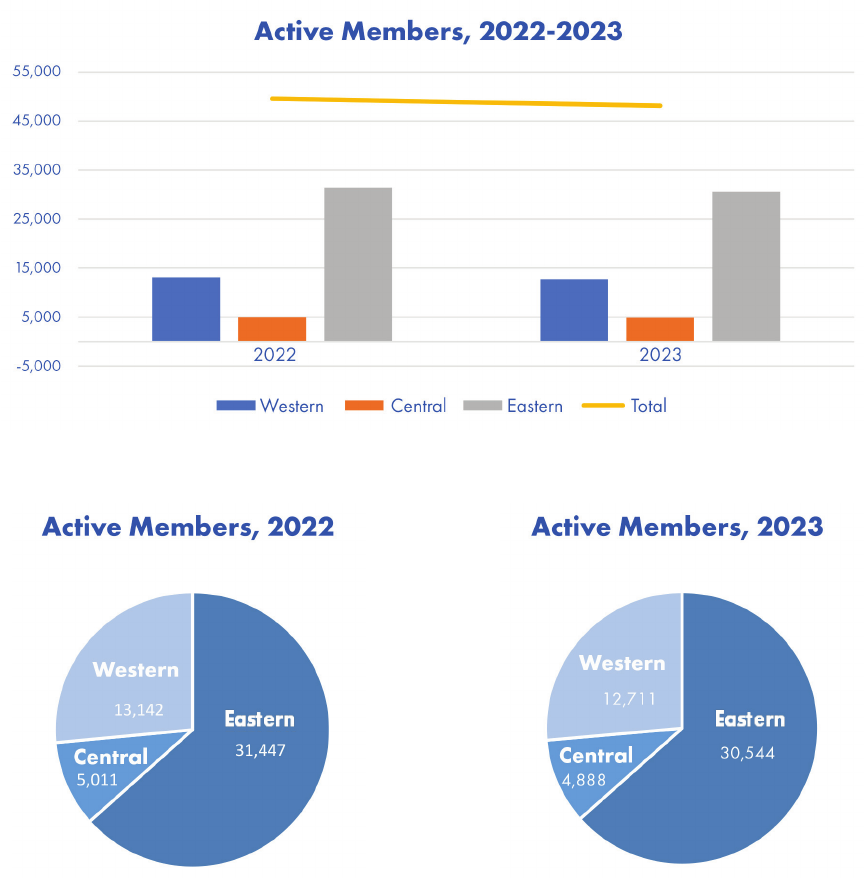
6
ere are many ways to quantify any union’s overall membership, and one of the most common
ways is active membership. Active membership includes members regardless of dues balance,
while not including members who have temporarily withdrawn from or formally suspended
payment of dues to the union. Looking at active membership by region for this season, the
geographic distribution of members in each region represents remained virtually unchanged
from last season, with the Eastern Region holding the largest share, followed by the Western
and Central Regions respectively. While these shares remain unchanged, there was a 2.9% drop
in total members from the previous season, down to 48,143 total active members as of June
2022, which aligned with the expiration of pandemic-era dues relief measures enacted by Equity.
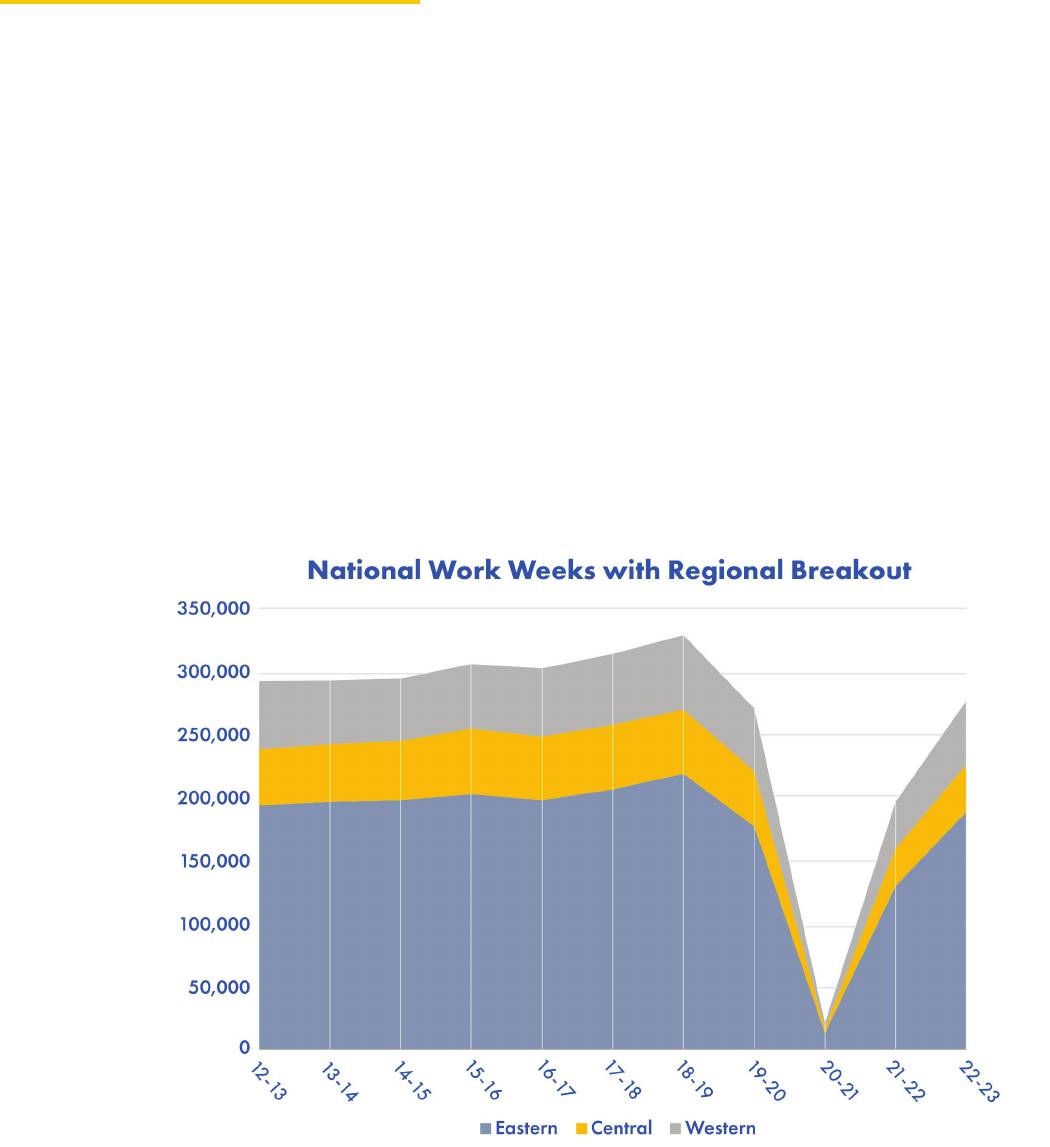
7
Work weeks are one of the key metrics that Actors’ Equity Association uses to analyze members’
employment. A work week is dened as a single week in which an individual member worked
for any amount of time. is allows us to account for the dierent lengths of individual member
contracts. A member does not need to work a whole week to have the work counted as a single
work week. e location and region associated with work weeks reects the location of the
employment, not the residence of the member employed.
ese rst two charts illustrate total work weeks, showing the combined regional work weeks
for the past 10 years and then each region’s work weeks broken out separately. is year we
continue the strong rebound from the loss of employment in the 2020–2021 season when
the industry shut down. e 2020–2021 season saw work week losses across all three regions
ranging between 91% and 93%. In this second season of recovery, regional work weeks increased
between 25% and 46% over the 2021–2022 levels.
WORK WEEKS
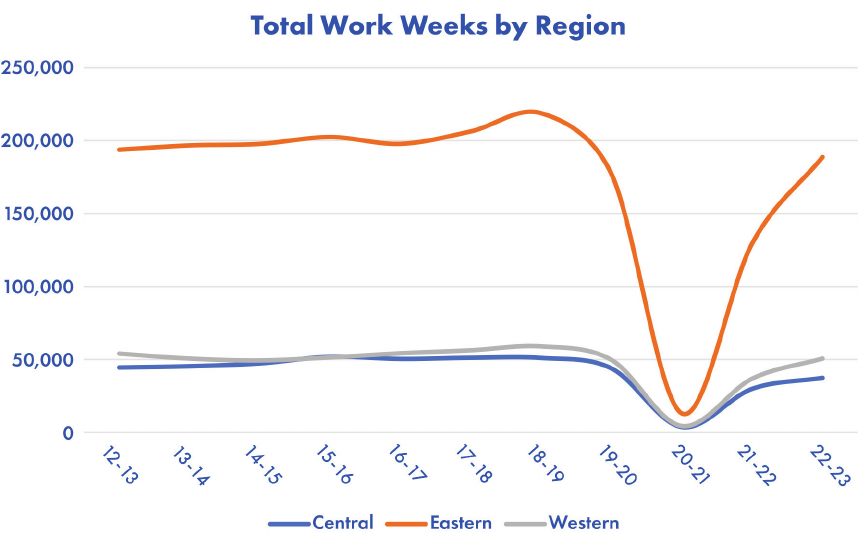
8
Looking rst to the Western Region, members worked a cumulative amount of 50,629 work
weeks, or 18.3% of all work weeks nationally. ese work weeks are an increase of 37.3% over
the 36,881 work weeks the previous season, while 14.2% below the record 2018–19 season.
In the Central Region, members worked a total of 37,422 work weeks, or 13.5% of all work
weeks this season. is is an increase of 25.1% over the 29,910 work weeks in 2021–22, and
73.3% of the work weeks earned in 2018–19.
Lastly, employment in the Eastern Region generated 188,706 work weeks, or 68.2% of all work
weeks. is is an increase of 45.6% above the 129,597 work weeks earned in the previous season,
though still 13.8% lower than the 2018–19 season.
Equity continues its eorts to ensure work week and employment opportunities increase for
the membership each year through a combination of organizing, contractual improvements and
industry health. We will see in the next section how member earnings oer another measure of
the theatrical season, and one with a sunnier outlook.
Many members seek work only as a stage manager, or only as a performer, and some performers
specialize in chorus work. is table shows work weeks for employment categories by nationally
and by region. Not only valuable in comparing work opportunities, this analysis is also critical
to Equity’s governance structure. Instead of the 10-year lookback we have employed elsewhere
in this report, we now focus only on the 6-year period referenced in Article 3, Section 2(c)
of Equity’s Constitution which denes how our National Council is composed, using these
statistics every 6 years.

9
Seasonal Work Weeks by Job Category and Region
National
Principal
Chorus
Stage Manager
Total
Central
Principal
Chorus
Stage Manager
Total
Eastern
Principal
Chorus
Stage Manager
Total
Western
Principal
Chorus
Stage Manager
Total
17-18
187,274
75,355
51,203
313,832
34,382
7,493
9, 319
51,194
112,573
62,084
31,673
206,330
40,319
5,778
10,211
56,308
18-19
195,910
77,455
55,423
328,788
33,061
8,108
9,901
51,070
121,038
63,073
34,649
218,760
41,811
6,274
10,873
58,958
19-20
163,504
61,418
45,638
270,560
29,243
6,145
8,487
43,875
99,399
49,706
27,898
177,003
34,862
5,567
9,253
49,682
20-21
13,496
2,109
4,379
19,984
2,538
12
846
3,396
7,880
1,959
2,393
12,232
3,078
138
1,140
4,356
21-22
113,604
39,737
33,968
187,309
20,349
2,456
5,661
28,466
69,010
33,497
20,757
123,264
24,245
3,784
7,550
35,579
22-23
176,204
57,154
43,399
276,757
27,843
3,004
6,575
37,422
112,213
48,828
27,665
188,706
36,148
5,322
9,159
50,629
Looking at the 2022–23 work weeks earned and again comparing them to the 2018–2019
season, we can take one measure of the industry’s return to its pre-pandemic heights. e chorus
work weeks nationally, for example, have not returned as robustly as either stage manager or
principal work weeks, with a particular lag in the Central Region.
National
Principal
Chorus
Stage Manager
Total
Central
Principal
Chorus
Stage Manager
Total
Eastern
Principal
Chorus
Stage Manager
Total
Western
Principal
Chorus
Stage Manager
Total
Work Weeks
89.9%
73.8%
78.3%
84.2%
84.2%
37.0%
66.4%
73.3%
92.7%
77.4%
80.0%
86.3%
86.5%
84.8%
84.2%
85.9%
2022-23 work
weeks as % of
18-19 work weeks

10
e following table provides a complete accounting of all work weeks from the 2022-23 season
by the underlying contractual agreement and region of employment.
Production
Point of Organization
Tours
Resident Theatre (LORT)
LORT Rep
LORT Non-Rep
Small Professional Theatre (SPT)
Letter of Agreement (LOA)
Short Engagement Touring (SETA)
Touring Agreement
Stock
COST
CORST
MSUA
RMTA
Developmental Agreement
Special Agreements
Theatre for Young Audiences (TYA)
Cabaret
Guest Artist
Special Appearance
University Theatre (URTA)
Dinner Theatre
Casino
Midsize
Business Theatre and Events
Staged Reading
Off-Broadway (NYC)
NYC-LOA
Mini (NYC)
Transition (NYC)
Showcase - LA
Showcase - NY
New England Area Theatre (NEAT)
Walt Disney World
Orlando Area Theatre (OAT)
Chicago Area (CAT)
Western Civic Light Opera (WCLO)
Hollywood Area (HAT)
San Francisco Bay Area (BAT)
Modified Bay Area Theatre (MBAT)
99 Seat Agreement
TOTAL
51,568
51,311
257
28,725
2,103
26,622
11,800
10,274
2,430
31,449
5,288
3,803
1,108
33
344
3,041
1,546
3,838
642
3,038
2,254
581
43
19
799
256
15,773
2,089
1,323
381
104
1,729
9,479
237
188,706
461
461
7,133
7,133
8,643
4,248
1,606
266
522
818
3,459
989
21
646
542
289
4,731
120
7
4,527
37,422
725
725
19,914
4,077
15,837
9,532
6,588
1,813
1,104
1,104
56
1,674
1,312
363
1,025
675
481
298
622
11
3
4
484
112
1, 319
197
2,317
50,629
52,754
52,497
257
55,772
6,180
49,592
29,975
21 ,11 0
2,430
33,262
7,998
5,173
1,630
851
344
3,097
6,679
6,139
1,026
4,709
3,471
1,351
5,072
622
19
930
266
15,773
2,089
1,323
381
4
104
1,729
9,479
237
4,527
484
112
1, 319
197
2,317
276,757
19.1%
19.0%
0.1%
20.2%
2.2%
17.9%
10.8%
7.6%
0.9%
12.0%
2.9%
1.9%
0.6%
0.3%
0.1%
1.1%
2.4%
2.2%
0.4%
1.7%
1.3%
0.5%
1.8%
0.2%
0.0%
0.3%
0.1%
5.7%
0.8%
0.5%
0.1%
0.0%
0.0%
0.6%
3.4%
0.1%
1.6%
0.2%
0.0%
0.5%
0.1%
0.8%
Eastern Central Western Total % of Total
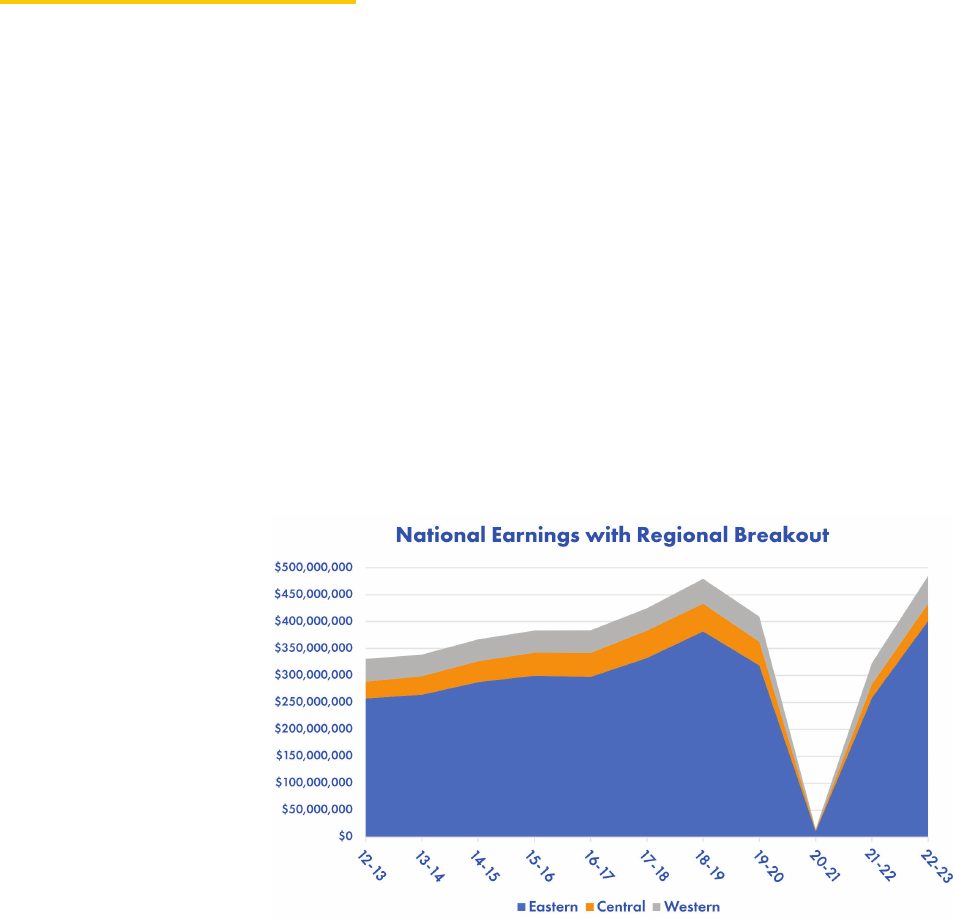
11
Earnings, of course, are the other important factor in assessing a given theatrical season. Due
to collectively negotiated contractual increases as well as individually negotiated terms, earnings
are tied to but not merely a reection of work weeks. We will now examine the season along the
same frames of reference we have employed previously for work weeks taking member earnings
into account. e region to which earnings are attributed, as with work weeks, refers to the
region in which the employment occurred regardless of the member’s residence.
Again, we begin with charts illustrating national employment as earned in each of the regions
for the past 10 years, and then a regional breakout of these statistics. e nancial opportunities
aorded to our membership reect a more robust recovery than work weeks post-pandemic:
a full recovery nationally. Members earned $484,919,343 nationally in 2022–23, exceeding
the previous record earnings of 2018–19 ($479,292,411) by 1.2% while 2022–23 work weeks
remained at 84.2% of 2018–19 work weeks. National earnings increased by 50.1% in 2022–23
from earnings in 2021–22.
EARNINGS
Looking rst to the Western Region, members collectively earned $51,766,855, or 10.7% of
all earnings. ese earnings are an increase of 31.2% over the $39,351,903 earned the previous
season and are 12.1% higher than the 2018–19 season.
Shifting to the Central Region, members earned $31,763,162, which is 6.6% of all earnings this
season. While Central earnings continue to improve post-shutdown (up 25.1% from 2021–22),
the economic recovery lags behind the other regions. Central member earnings remain at 61.7%
of the record 2018–19 season.
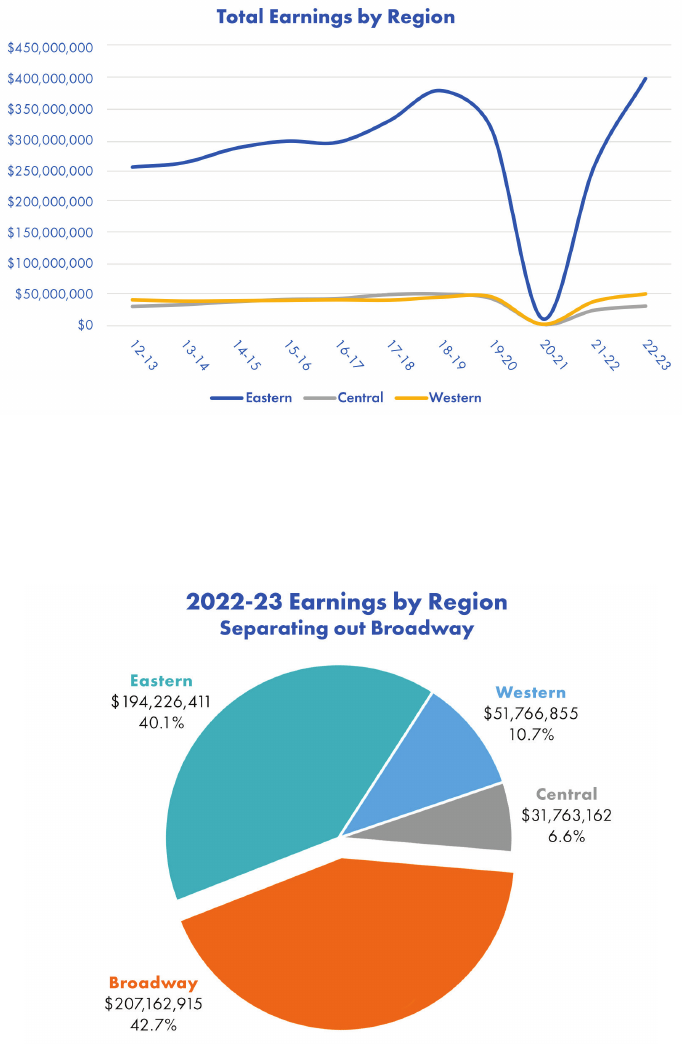
12
Lastly, the Eastern Region, including the income-leading Broadway employment, represented
82.8% of national member earnings, generating $401,389,326 this season. An increase of 55.2%
over 2021–22, these earnings are also 5.2% higher than 2018–19.
As noted previously, Broadway is an income leader to an outsized degree beyond its work weeks.
Broadway income alone represented 42.7% of the national earnings. But Broadway employment
alone does not account for the Eastern concentration of national nancial opportunities, as
illustrated in this graph. Of the $401,839,326 earned in the Eastern Region, $194,226,411
(48.3%) was earned in non-Broadway employment in 2022-23. Without Broadway earnings,
Eastern Region earnings were 3.7 times those in the Western Region, and 6.1 times those in the
Central Region (both other regions still counting any sit-down employment on the Production
Contract).

13
Production
Point of Organization
Tours
Resident Theatre (LORT)
LORT Rep
LORT Non-Rep
Small Professional Theatre (SPT)
Letter of Agreement (LOA)
Short Engagement Touring (SETA)
Touring Agreement
Stock
COST
CORST
MSUA
RMTA
Developmental Agreement
Special Agreements
Theatre for Young Audiences (TYA)
Cabaret
Guest Artist
Special Appearance
University Theatre (URTA)
Dinner Theatre
Casino
Midsize
Workshop
Business Theatre
Staged Reading
Royalties
Filming and Taping
Off-Broadway (NYC)
NYC-LOA
Mini (NYC)
Transition (NYC)
New England Area (NEAT)
Walt Disney World
Orlando Area (OAT)
Chicago Area (CAT)
Western Light Opera (WCLO)
Hollywood Area (HAT)
San Francisco Bay Area (BAT)
Modified Bay Area Theatre (MBAT)
99 Seat Agreement
TOTAL
Eastern
$252,305,851
$207,162,919
$45,142,933
$31,075,695
$1,895,409
$29,180,285
$7,573,427
$7,804,888
$18,964,342
$33,621,266
$5,648,072
$4,003,308
$974,531
$75,524
$594,709
$3,518,588
$1,784,761
$2,089,589
$609,531
$1,930,531
$991,380
$1,093,292
$25,683
$37,931
$21,488
$961,611
$2,365
$270,003
$21,822
$16,752,941
$1,438,402
$978,673
$197,260
$1,114,422
$10,441,915
$113,595
$401,389,326
82.77%
Central
$1,222,793
$1,222,793
$8,068,989
$8,068,989
$5,254,092
$3,662,551
$1,678,147
$337,180
$318,566
$1,022,401
$1,991,663
$623,620
$12,198
$390,026
$224,961
$335,918
$4,718,149
$120,000
$3,460,057
$31,763,162
6.55%
Western
$7,610,390
$7,610,390
$23,502,728
$5,151,548
$18,351,180
$5,454,158
$4,431,432
$2,087,941
$1,152,768
$1,152,768
$19,447
$1,694,051
$723,490
$301,225
$682,363
$254,004
$517,904
$178,734
$718,263
$6,600
$665,086
$72,880
$978,620
$77,746
$637,024
$51,766,855
10.68%
Total
$261,139,035
$215,996,102
$45,142,933
$62,647,412
$7,046,957
$55,600,455
$18,281,677
$15,898,871
$18,964,342
$35,709,207
$8,478,987
$5,493,256
$1,293,097
$1,097,925
$594,709
$3,538,036
$5,470,474
$3,436,700
$922,954
$3,002,920
$1,470,345
$1,947,115
$4,922,565
$718,263
$37,931
$21,488
$1,088,211
$2,365
$270,003
$21,822
$16,752,941
$1,438,402
$978,673
$197,260
$1,114,422
$10,441,915
$113,595
$3,460,057
$665,086
$72,880
$978,620
$77,746
$637,024
$484,919,343
% of Total
53.85%
44.54%
9.31%
12.92%
1.45%
11.47%
3.77%
3.28%
3.91%
7.36%
1.75%
1.13%
0.27%
0.23%
0.12%
0.73%
1.13%
0.71%
0.19%
0.62%
0.30%
0.40%
1.02%
0.15%
0.01%
0.00%
0.22%
0.00%
0.06%
0.00%
3.45%
0.30%
0.20%
0.04%
0.23%
2.15%
0.02%
0.71%
0.14%
0.02%
0.20%
0.02%
0.13%
e following table provides a complete accounting of all earnings from the 2022–23 season by
underlying contractual agreement and region of employment.
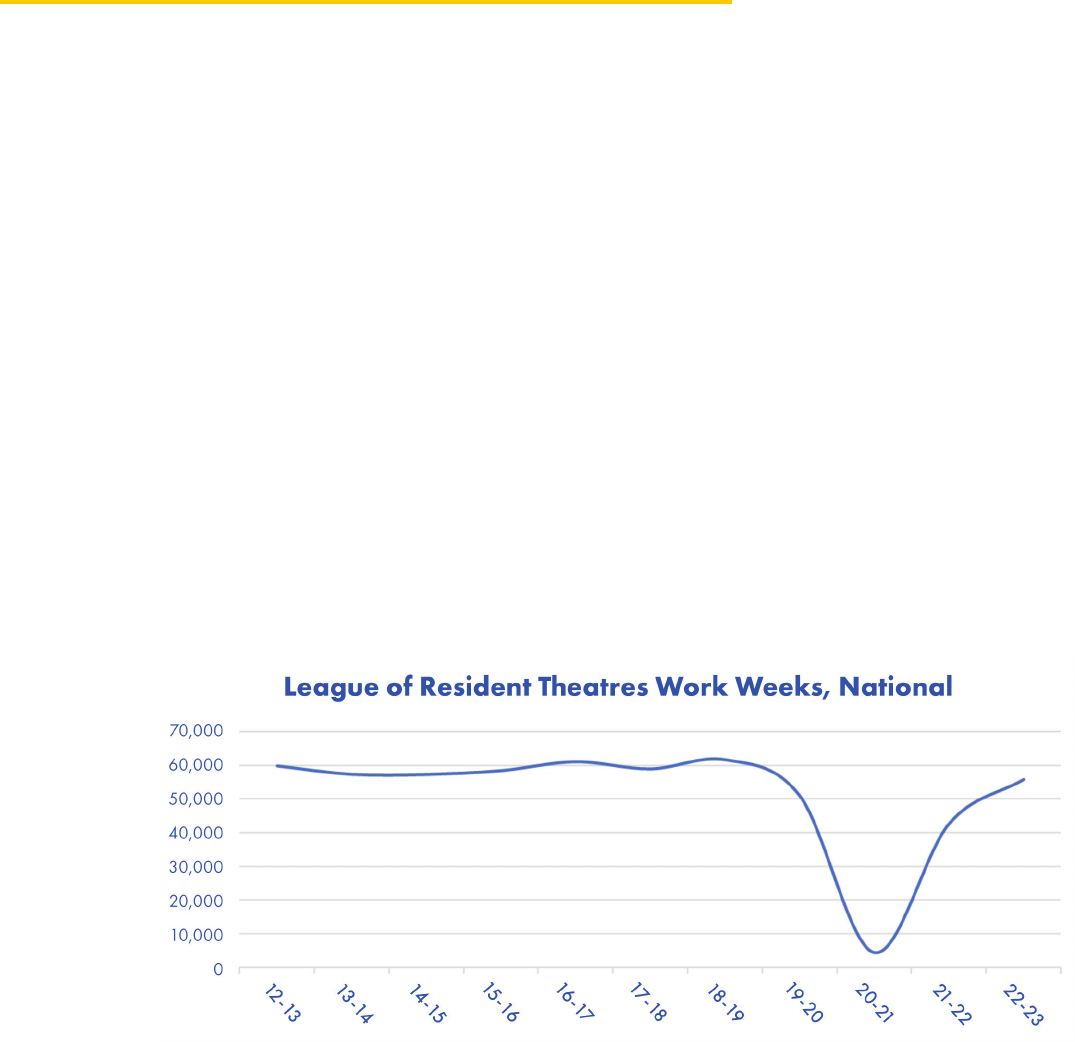
14
In this section we will look more closely at the three collectively bargained agreements which
each represent at least 10% of both annual work weeks and member earnings.
LORT
e League of Resident eatres (LORT) has 80 member theatres in 30 states and the District
of Columbia. Since 1965 the League of Resident eatres Agreement has consistently been one
of the largest generators of work weeks for members without being consigned to a single region.
During the 2022–23 season, a few LORT producers have made headlines with downsizing
eorts, seasonal hiatuses or unfortunate closures. Future seasons may reect declines in work
weeks or earnings, but such eects are not notable in the 2022–23 season. is theatrical
season, the LORT Agreement continued its post-pandemic recovery with 55,772 work weeks,
providing 20.2% of all national work weeks. at is a LORT-earned work week increase of
30.7% more work weeks than in 2021–22, to 90.5% of the work weeks in 2018–19. e Western
and Eastern Regions fared slightly better than the Central. Western LORT work weeks were
93.6% of their 2018–19 numbers while Eastern LORT work weeks were 91.0% and Central
LORT work weeks were 81.1% of their respective 2018–19 employment.
LORT, Touring, Production Details
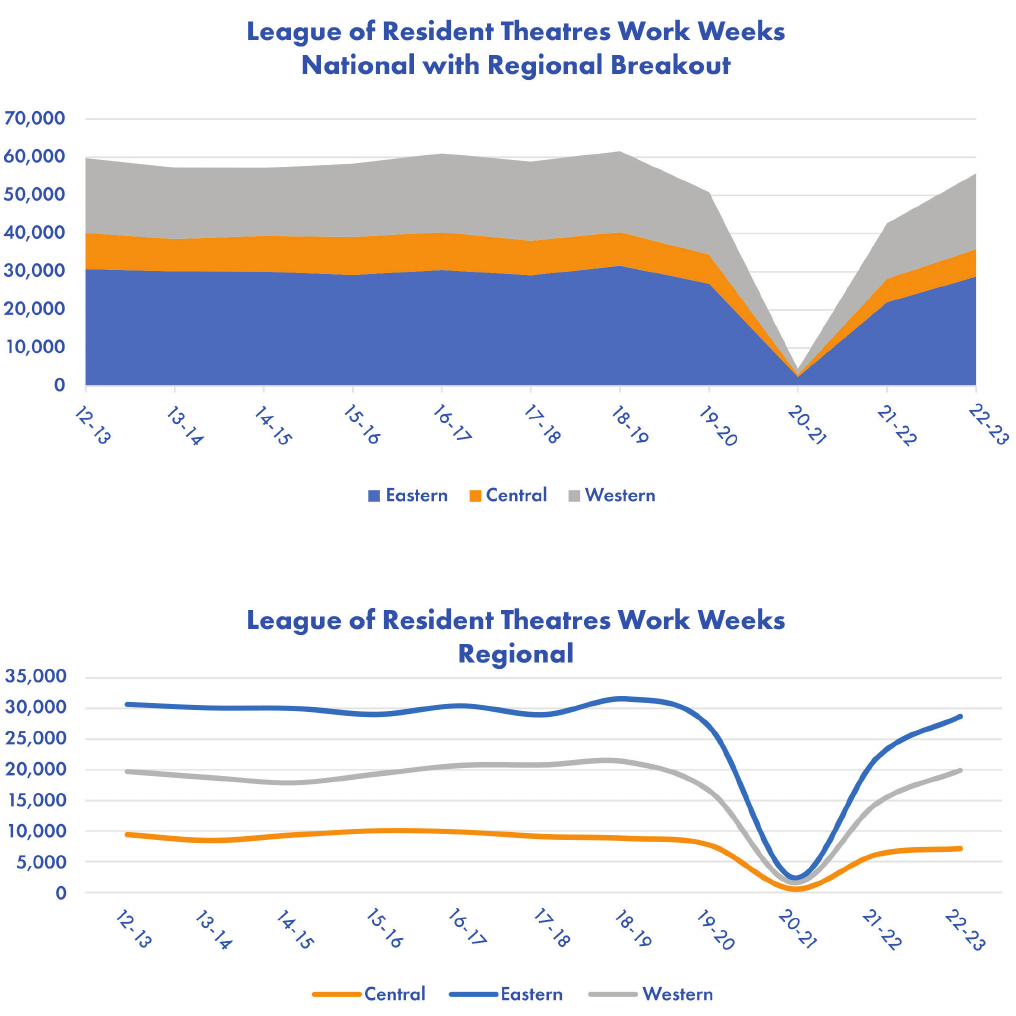
15
Nationally, LORT employment provided $62,647,412 in member earnings, 99.8% of the 2018–
19 LORT earnings and 12.9% of all earnings in 2022-23.
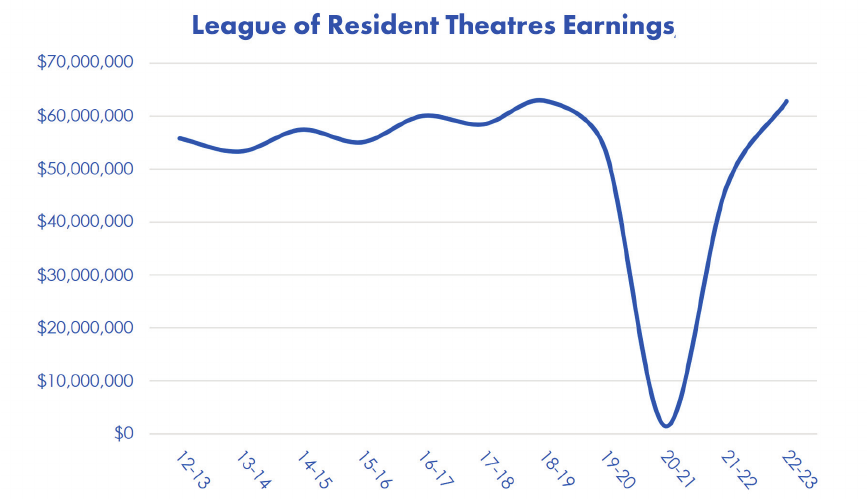
16
TOURING
Agreements covering national tours have their contractual origins in the Production Contract.
First negotiated in 1919, the Production Contract is the oldest agreement that Equity
collectively bargains and administers. Historically covering both sit-down productions (also
known as Point of Organization productions) including Broadway and tours (national and
tiered), during this season Equity negotiated a separate agreement for touring bringing together
national, tiered and short engagement touring. is contractual realignment was a long-sought
institutional goal and achieved many needed and deserved improvements for members touring
on both the Production Contract and the Short Engagement Touring Agreement (SETA). is
consolidation to a unied Touring Agreement does, however, provide a momentary statistical
challenge in providing seasonal gures and context for this annual report. For long-term analytic
reasons and contractual administration, the productions that were touring on the Monday
following the new agreement’s ratication (May 1, 2023) and continued touring on the new
Touring Agreement have been retroactively classied to the Touring Agreement to their rst
employment date in previous seasons, while those that had closed prior to ratication have
retained their historic classication.
To better contextualize the Production Contract statistics examined in the next section, with
touring removed for the rst time in Equity’s history, our analysis will start with Touring,
looking at all touring employment historically. In 2022–23, tours (including Tiered Tours) on
Production, SETA and the new Touring Agreement provided 34,627 work weeks, 87.2% of the
39,730 work weeks earned in 2018–19 on the then-existing touring agreements.
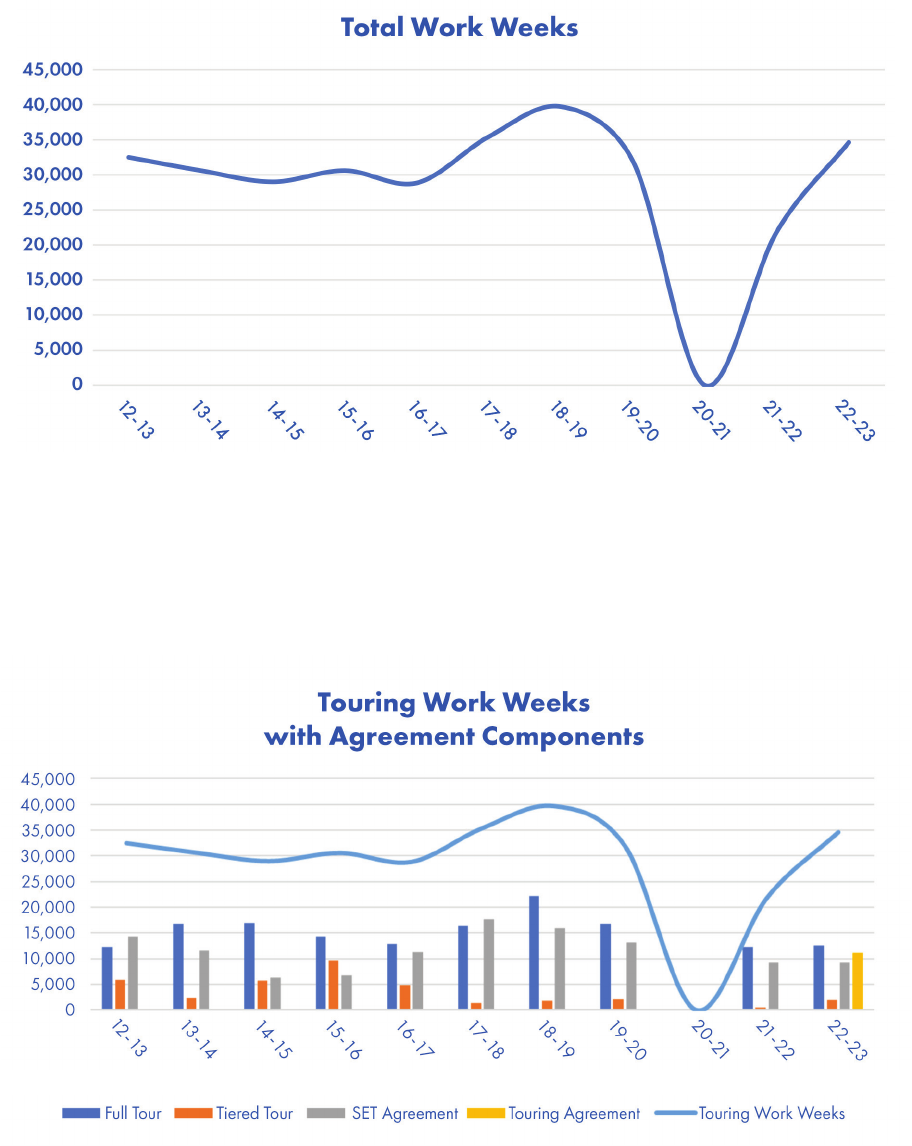
17
With the vast majority of tours now operating under the Touring Agreement, the following
chart shows the historic distribution and contribution to work weeks of each national touring
agreement.
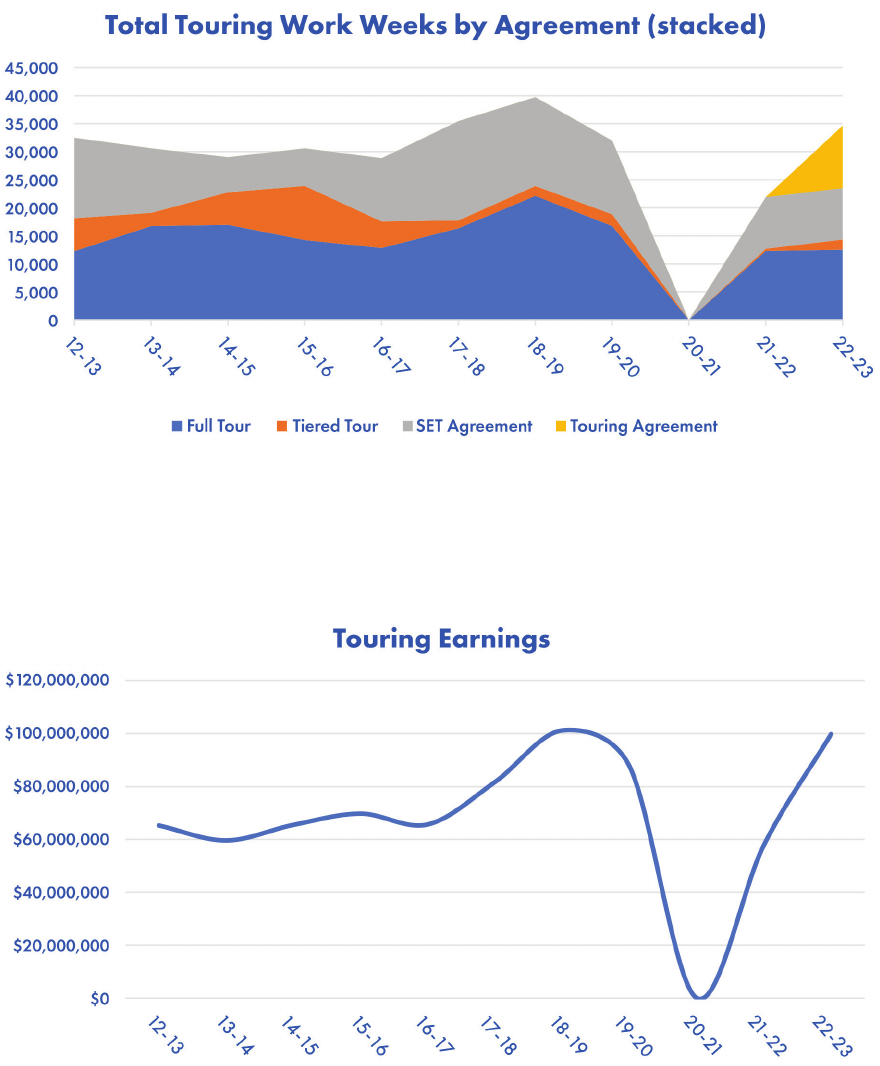
18
Touring employment across three agreements earned members $99,816,480 in 2022–23, 98.6%
of the record $101,213,443 earned in 2018–19.
Looking at the component agreements, again please note that in the chart below historic
earnings are attributed to the agreement that was in place either at the tour’s conclusion or in
place as the tour continues after the new agreement was ratied. In subsequent annual reports,
all national touring employment will be categorized under the new contract, the Touring
Agreement.
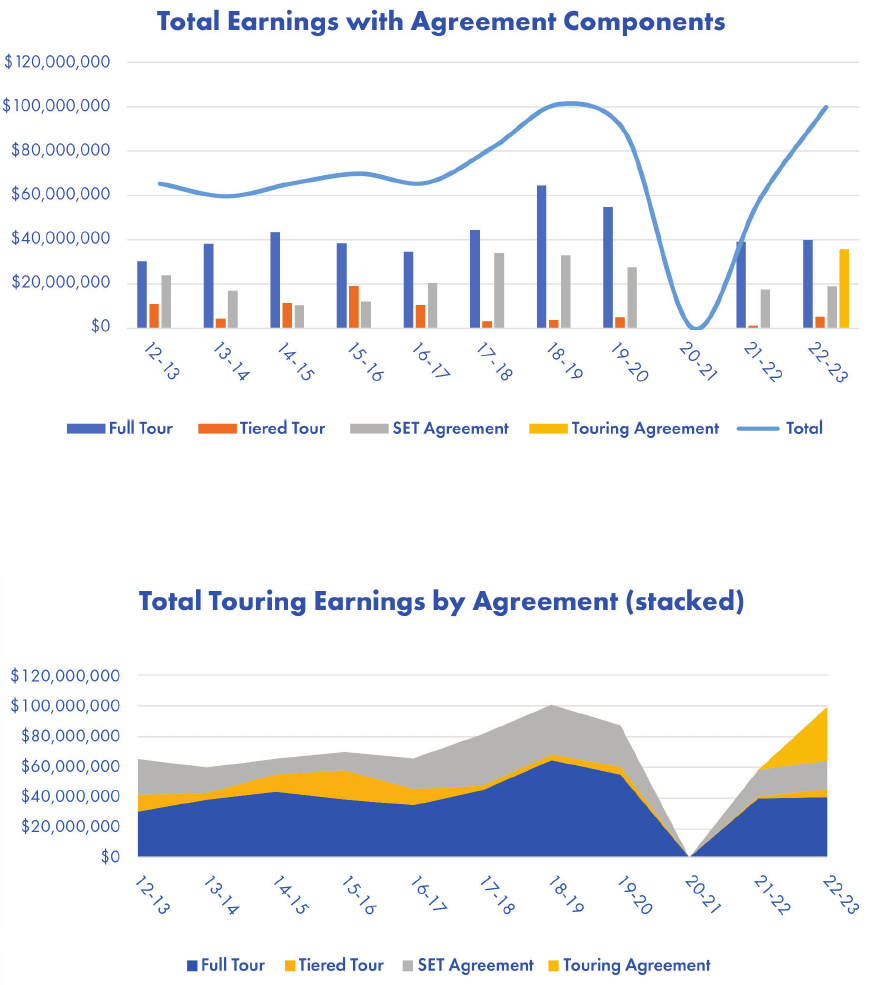
19
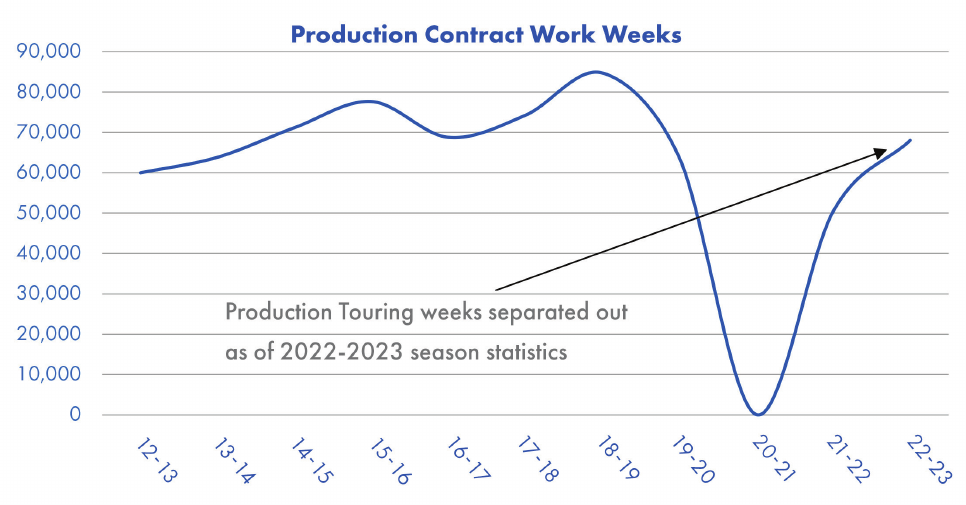
20
In order to look at the Production Contract in context, we can isolate the non-touring
employment on the agreement historically to the 2007–08 season. In previous reports,
non-touring employment on the Production Contract is denoted as Point of Organization
employment.
Nationally in 2022–23, members worked for 52,497 work weeks in sit-down Production
Contract employment. at’s a 38.9% increase over the previous season post-shut down, and a
return to 86.3% of the high mark set by the 2018–19 season. Earnings on these contracts again
tell a dierent story of recovery.
PRODUCTION
With this sizeable portion of touring employment that previously was on the Production
Contract reassigned to touring statistics, it is not surprising the following chart gives a
misperception of lost work on the Production Contract. is includes sit-down productions
outside of New York City as well as Broadway.
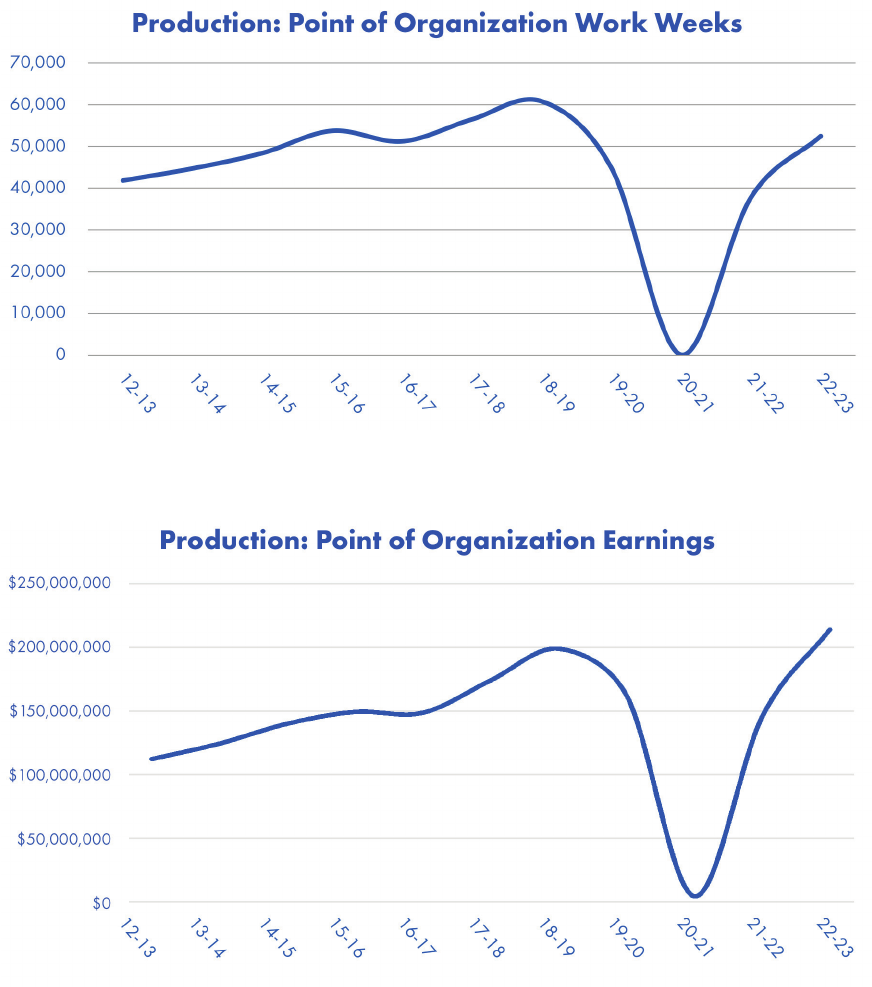
21
As a result of collectively bargained contractual increases and terms individually negotiated by
members, the 2022–23 earnings ($215,996,102) exceeded by 7.8% the earnings in 2018–2019
($200,456,656). e increase in earnings colors the impact of the slower return to pre-pandemic
employment.

22
Race or Ethnicity
Asian or Asian American
Black or African American
Hispanic or Latin American
Indigenous Hawaiian or Pacific Islander
Indigenous North American
Middle Eastern or North African
Multi-Racial or Multi-Ethnic
White or European American
Prefer Not To Say
Not Provided
National Total
%
Female
656
2,201
811
23
44
48
1,377
15,595
1,251
2,335
24,341
50.56%
Male
463
2,148
889
33
44
50
1,086
15,004
1,140
2,328
23,185
48.16%
8
36
22
1
62
194
13
8
344
0.71%
Non-Binary/
Third Gender
2
2
2
1
1
10
33
77
6
134
0.28%
Prefer Not
to Say
2
7
5
1
1
10
35
4
1
66
0.14%
Prefer to
Self-Describe
1
6
1
2
7
6
50
73
0.15%
Not
Provided
Total
1,132
4,400
1,730
56
90
101
2,547
30,868
2,491
4,728
48,143
%
2.35%
9.14%
3.59%
0.12%
0.19%
0.21%
5.29%
64.12%
5.17%
9.82%
e demographics in the table above are generated at the end of the season each year. is table
reects the active membership based on how members self-identify their gender and race or
ethnicity, information which the union maintains under strict condentiality. is report simply
looks at our membership at a specic point in time.
Even though we look at membership at a given moment in time above, Equity’s membership
is not static. Between 1991 and 2019, Equity added an average of 2,302 new members each
theatrical season. In 2022–23, Equity added 2,303 new members, continuing to build on the
Open Access membership policy and newly organized work opportunities.
From the outward view of employment, we shift to the critical inward analysis of our
membership. Equity members provide not only the union’s strength but through their
participation in governance and negotiations they dene the union’s goals. A union is nothing
without its members, but who is Equity? Each year this report takes a moment to examine the
people that make up Equity’s membership, expanding on the regional gures discussed in the
Year In Review section of this report.
MEMBERSHIP
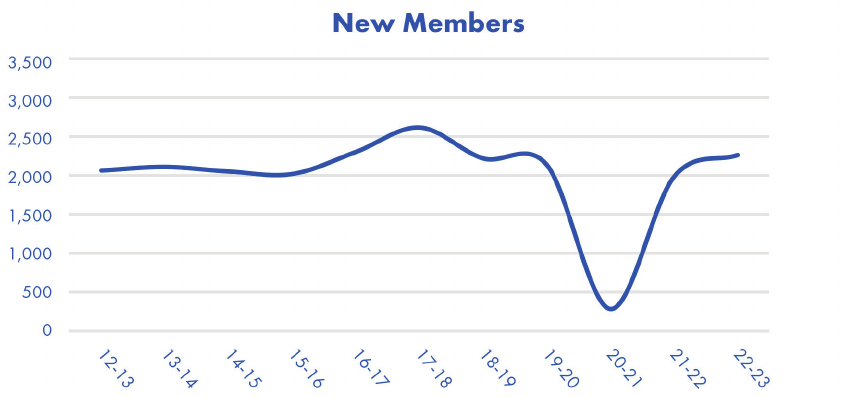
23
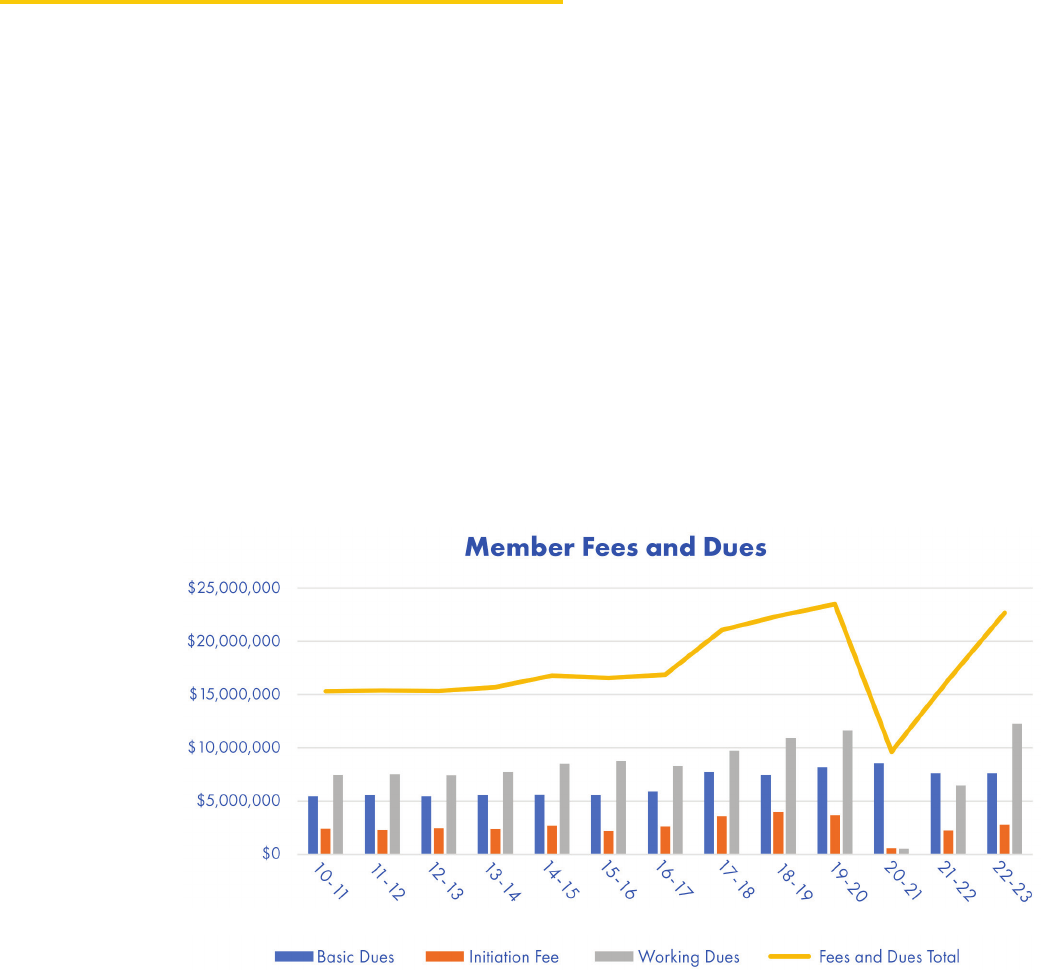
24
Up until this section, this report has analyzed data and shared statistics from the eatrical
Season which Equity has dened as June to May of the following year. However, for this section
we shift our focus to data that correlates to Equity’s scal year which runs from April to March
of the following year.
Equity has three categories of member-generated revenue: initiation fees, basic dues and
working dues. With the exception of the two years of industry shut down, this revenue accounts
for the majority of the funds which enable Equity to represent members and enforce its
collectively bargained agreements. e initiation fee is the initial payment made when a member
joins the union. is fee doesn’t have to be paid in one lump sum upfront and generally is paid
in installments when a member is working. Basic dues are collected from all members biannually
in the spring and fall. Collected when a member is working on an Equity contract, working dues
are calculated as a percentage of a member’s Equity-contracted income.
FINANCES (unaudited)
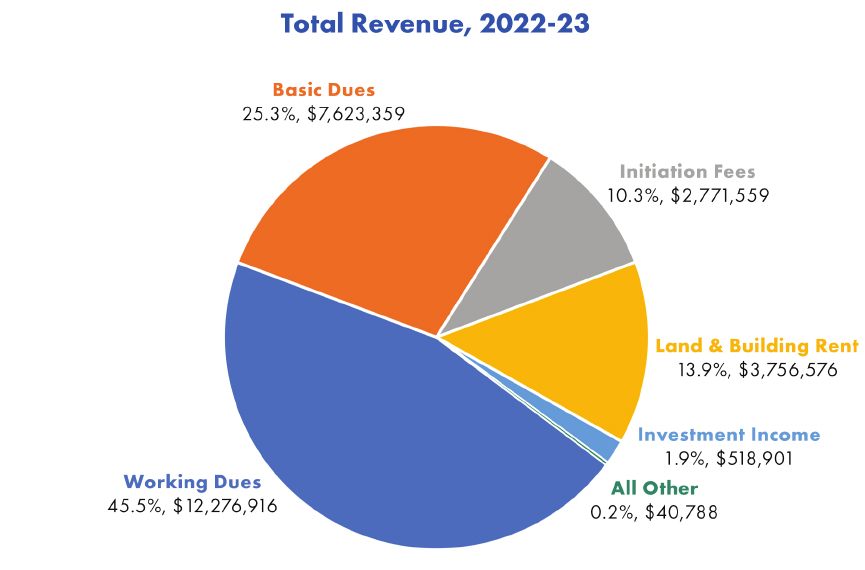
25
In addition to these three member-generated revenue streams, Equity has investments (both
nancial assets and real estate holdings) which account for 16.0% of Equity’s 2022–23 revenue.
Equity’s property-related revenue is generated by the land it owns in Times Square, New
York City, the building it owns in the West Loop, Chicago, and the building it owns in North
Hollywood, Los Angeles.
is nal chart illustrates Equity’s expenses. Most of Equity’s expenses go directly towards
maintaining member services:
• the dedicated sta that keeps the union running strong (payroll and
fringes);
• the oces and the information technology, including maintenance
with which they provide these services (oce expenses and information
technology);
• direct member services expenses, including all governance-related
expenses, contract negotiations and ratications;
• member communication and travel to worksites to inspect conditions,
meet directly with members and enforce contractual terms.
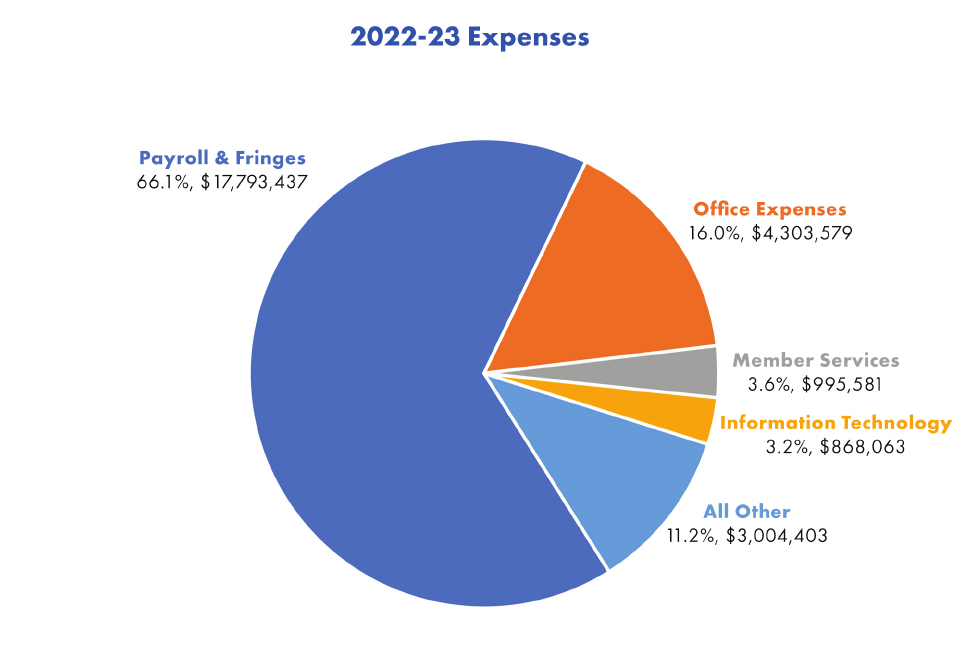
26
e industry shutdown in 2020 aected the union’s nances as well as those of its members.
As we look to all measures of our industry’s recovery, we conclude this nancial section of the
report noting that, following a period during which Equity’s council appropriated reserves
to maintain necessary member services, Equity was able to resume full operations while
maintaining nancial stability.

27
ere is great value in stepping back to assess the entire industry’s health from a distance,
be it a backward look to the most recent theatrical season or gathering context from further
back in the business’s history. But no matter what landscape we lay out, you should recognize
yourself as part of that scene. is report tells multiple stories, and they are all important. e
nancial health of Broadway has undeniable ripple eects for the rest of our union, but the lost
employment evidenced in the reduced work weeks and the lagging recovery elsewhere represent
actual members who are still suering from the pandemic’s eects on live theatre.
I see this report as adding another chapter to Equity’s long tradition of keeping both the
concerns of individual members and live theatre’s evolving needs at the heart of all its
decisions. If you’re an Equity member, this report is meant to provide a view of how the entire
membership is faring in this challenging recovery period, to add to what you know about how
you personally are faring. I hope you can bring your personal experiences seeking work and
in the workplace to color what’s shared here and to deepen your own understanding of the
industry. Together we can continue to make inroads for increased work opportunity, improve
working conditions, and to address your concerns for where live theater is headed.
is eatrical Season Report could not have been written alone, and it builds on the exemplary
work of previous authors Joey Stamp and Steve DiPaola. Assistant Executive Director for
Finance and Administration Regina Garlin and Controller Bryant Lee provided insight and
all data regarding Equity’s nances. None of the statistics on employment and earnings would
be possible without the diligent, daily eorts of the membership associates and the contract
membership associates overseen by Director of Membership John Fasulo and Director of
Contracts Katey Schwartz. e visual and textual assistance from Communications Director
David Levy, Designer Noah Diamond and Senior Writer and Project Manager Gabriela
Geselowitz were invaluable. And it is impossible to overstate the important contributions of
Director of Information Technology Doug Beebe, whose understanding of Equity’s workings
and its data is unsurpassed. Now in my third decade at Equity, it remains a privilege to work
alongside a sta dedicated to serving professional artists.
CURTAIN CALL

